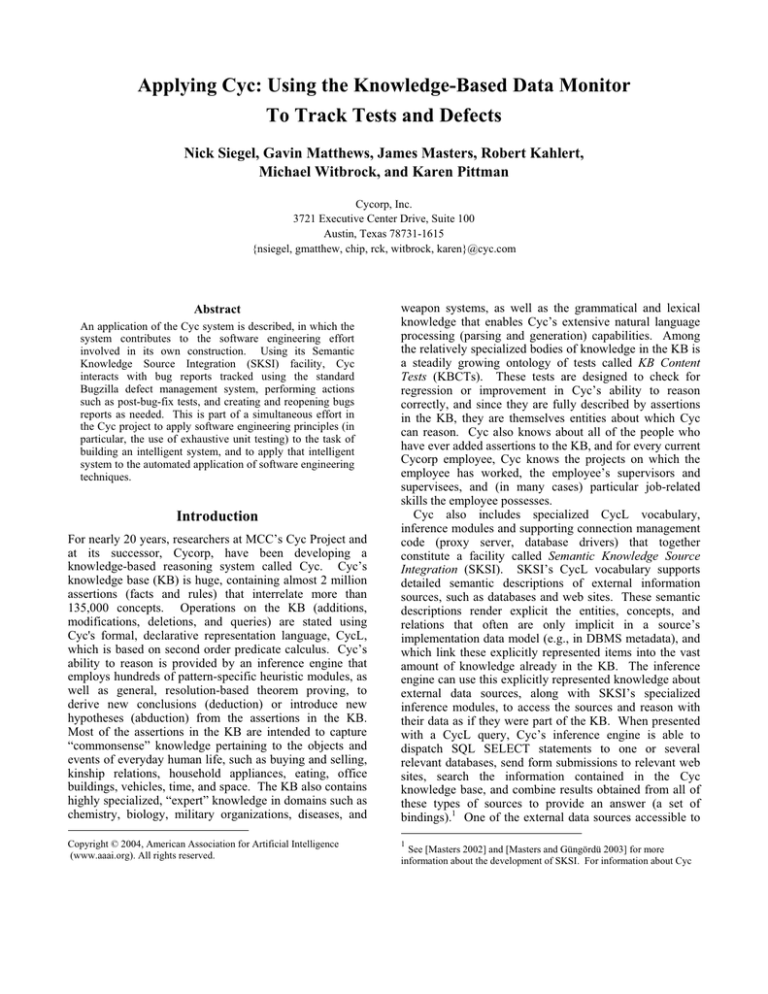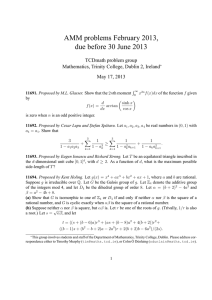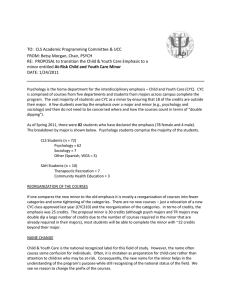
Applying Cyc: Using the Knowledge-Based Data Monitor
To Track Tests and Defects
Nick Siegel, Gavin Matthews, James Masters, Robert Kahlert,
Michael Witbrock, and Karen Pittman
Cycorp, Inc.
3721 Executive Center Drive, Suite 100
Austin, Texas 78731-1615
{nsiegel, gmatthew, chip, rck, witbrock, karen}@cyc.com
Abstract
An application of the Cyc system is described, in which the
system contributes to the software engineering effort
involved in its own construction. Using its Semantic
Knowledge Source Integration (SKSI) facility, Cyc
interacts with bug reports tracked using the standard
Bugzilla defect management system, performing actions
such as post-bug-fix tests, and creating and reopening bugs
reports as needed. This is part of a simultaneous effort in
the Cyc project to apply software engineering principles (in
particular, the use of exhaustive unit testing) to the task of
building an intelligent system, and to apply that intelligent
system to the automated application of software engineering
techniques.
Introduction
For nearly 20 years, researchers at MCC’s Cyc Project and
at its successor, Cycorp, have been developing a
knowledge-based reasoning system called Cyc. Cyc’s
knowledge base (KB) is huge, containing almost 2 million
assertions (facts and rules) that interrelate more than
135,000 concepts. Operations on the KB (additions,
modifications, deletions, and queries) are stated using
Cyc's formal, declarative representation language, CycL,
which is based on second order predicate calculus. Cyc’s
ability to reason is provided by an inference engine that
employs hundreds of pattern-specific heuristic modules, as
well as general, resolution-based theorem proving, to
derive new conclusions (deduction) or introduce new
hypotheses (abduction) from the assertions in the KB.
Most of the assertions in the KB are intended to capture
“commonsense” knowledge pertaining to the objects and
events of everyday human life, such as buying and selling,
kinship relations, household appliances, eating, office
buildings, vehicles, time, and space. The KB also contains
highly specialized, “expert” knowledge in domains such as
chemistry, biology, military organizations, diseases, and
Copyright © 2004, American Association for Artificial Intelligence
(www.aaai.org). All rights reserved.
weapon systems, as well as the grammatical and lexical
knowledge that enables Cyc’s extensive natural language
processing (parsing and generation) capabilities. Among
the relatively specialized bodies of knowledge in the KB is
a steadily growing ontology of tests called KB Content
Tests (KBCTs). These tests are designed to check for
regression or improvement in Cyc’s ability to reason
correctly, and since they are fully described by assertions
in the KB, they are themselves entities about which Cyc
can reason. Cyc also knows about all of the people who
have ever added assertions to the KB, and for every current
Cycorp employee, Cyc knows the projects on which the
employee has worked, the employee’s supervisors and
supervisees, and (in many cases) particular job-related
skills the employee possesses.
Cyc also includes specialized CycL vocabulary,
inference modules and supporting connection management
code (proxy server, database drivers) that together
constitute a facility called Semantic Knowledge Source
Integration (SKSI). SKSI’s CycL vocabulary supports
detailed semantic descriptions of external information
sources, such as databases and web sites. These semantic
descriptions render explicit the entities, concepts, and
relations that often are only implicit in a source’s
implementation data model (e.g., in DBMS metadata), and
which link these explicitly represented items into the vast
amount of knowledge already in the KB. The inference
engine can use this explicitly represented knowledge about
external data sources, along with SKSI’s specialized
inference modules, to access the sources and reason with
their data as if they were part of the KB. When presented
with a CycL query, Cyc’s inference engine is able to
dispatch SQL SELECT statements to one or several
relevant databases, send form submissions to relevant web
sites, search the information contained in the Cyc
knowledge base, and combine results obtained from all of
these types of sources to provide an answer (a set of
bindings).1 One of the external data sources accessible to
1
See [Masters 2002] and [Masters and Güngördü 2003] for more
information about the development of SKSI. For information about Cyc
Cyc via SKSI is the Cyc Test Repository (CTR), a database
that contains the archived results of weekly KB Content
Test runs.
Cycorp currently uses Bugzilla2 to track software
defects. Cycorp’s Bugzilla installation (which is fairly
standard, with a few customizations unrelated to the
capabilities described in this paper) includes the Bugzilla
database, in which data about software defects is stored,
and a Perl CGI script that generates a web interface via
which users can view and modify the defect data. Since
both the web interface and the database’s data model have
been described in the Cyc KB using the required SKSI
vocabulary, Cyc can query or modify existing bug reports,
and can open new bug reports. Furthermore, since the
CycL vocabulary for defining KB Content Tests includes a
predicate for associating one or more specific tests with
one
or
more
specific
bug
reports
(#$testQueryForBugzillaBug), Cyc can track and reason
about this association.
The integration of Cyc’s declarative, semantically rich
representation of KB Content Tests with the ability to
access, via SKSI, both the archived test results in the Cyc
Test Repository, and the defect reports in Bugzilla, has
been the near-term development goal of a broader Cycorp
effort called Knowledge-Based Data Monitoring (KBDM).
The next section of this paper describes our KBDM effort
in more detail, focusing specifically on the pieces that
contribute to the defect tracking framework currently
under development, and describing scenarios for its use.
Knowledge-Based Data Monitoring
The primary goal of Cycorp’s KBDM effort has been to
use Cyc’s knowledge base and inference engine to develop
software applications (a) that can integrate multiple,
structured data sources; and (b) that can monitor, and act
upon, user-specified changes (triggering conditions) in the
information those sources contain. Over the past two
years, our KBDM work has focused mainly on laying the
foundation for SKSI, and on developing the CycL
vocabulary, schema mapping tools, and conventions
(abstraction layers, both in code and in the knowledge
base) required to allow Cyc to access external data sources
and use their information in inference. We have only
recently turned to the task of implementing a prototype
monitor application that can check for, and respond to,
user-specified changes in the various information sources
accessible to Cyc (including both Cyc’s own knowledge
base, and the external sources described in it). Building a
prototype that enables Cyc to monitor its own test results,
and to create or modify bug reports associated with
and its capabilities, see the white papers and other material available at
Cycorp’s web site, http://www.cyc.com.
2
For general information about Bugzilla, go to http://www.bugzilla.com.
An overview of Bugzilla’s data model is available at
http://www.ravenbrook.com/project/p4dti/master/design/bugzillaschema/.
specific tests, seemed a worthwhile first step. It exercises
SKSI, since it requires Cyc to access an external web site
and two external databases as well as the test definitions
currently stored in the KB. It also imparts to Cyc a degree
of agency, an ability to participate in its own maintenance
and improvement, that we intend to extend much further.
In the Introduction, we indicated some of the conceptual
and programmatic pieces that make up the KBDM
prototype in its current state of primitive nascence. In the
next subsection, Architecture, we provide a more complete
list of these components, describing the nature and
function of each. Then, in the Scenarios subsection, we
explain how the components figure in a few specific data
monitoring (test and defect management) situations.
Architecture
KB Content Tests. At the time of writing, the Cyc
knowledge base contained 2606 KBCTs, with new tests
being added at a rate of dozens per week. Each test is a
fully reified, declaratively represented instance of the
collection (type, class) denoted by the CycL term
#$KBContentTestSpecification.
Each test definition
includes the specification of a CycL query and the results
(bindings) that would constitute a successful test run. The
current vocabulary makes it possible to state and capture
dozens of metrics for each test, such as the total number of
bindings returned, the number of bindings returned in 30
seconds, the total time required to retrieve the results that
constitute “success”, and a token indicating the reason
inference halted. Each test definition also includes an
assertion identifying the person (or agent) responsible for
the test, and (as mentioned in the Introduction) assertions
identifying any associated bug reports. Tests are organized
(grouped) in a hierarchy of collections, with the primary
structuring principle being the Cycorp project
(administrative category or research effort) to which a test
pertains. Individual tests may be linked to a Cyc project
via the CycL predicate #$testResponsibleProject. Entire
collections of tests may be linked to a project via the
predicate #$testCollectionProjectResponsible. Tests may
be run individually, or by collection (i.e., in batch mode).
See Figure 1 for an example of a KB Content Test as it
appears in Cyc’s Query Library interface.
Projects. At Cycorp, the word “project” generally means a
distinct administrative category or research effort. Projects
are denoted by terms in the Cyc KB, such as
#$SKSIProject. Each such project is a member of the
collection denoted by the term #$Project. KB Content
Tests are typically created for specific projects, and are
typically organized in the KB according to the project they
serve. Also, projects are associated with Bugzilla products
via the CycL predicate #$bugzillaProductForProject.
Cyc Test Repository. The Cyc Test Repository (CTR) is
the database in which the results of KB Content Test runs
are stored. Each test result is time-stamped, and includes a
record indicating the specific test version (tests may be run
with varying inference parameter settings, resulting in
Figure 1: An example of a KB Content Test as it appears in the Query Library interface.
different test versions), KB version, Cyc System version
and (when relevant) UI version in which the test was run.
Cyc understands the contents of the CTR and is able to
query it via SKSI.
Cyc Test Repository Schemata. In order for Cyc to
access and use (reason about) an external data source, the
source’s data model (table schemata and other metadata)
must be represented in the Cyc KB with the specialized
vocabulary created for the SKSI framework. This has
been done for the CTR’s data model.
Task Scheduler. The Cyc Task Scheduler is a
subcomponent of the Cyc System that enables users to
declaratively define and schedule system actions. The
CycL predicates
#$taskSchedulerCondition,
#$taskSchedulerAction, and
#$taskSchedulerTaskExpression
make it possible to define task initiation conditions,
specify primary task actions, and (if necessary) cause
named, parameterized blocks of executable code to be run,
by adding assertions to the KB. Other predicates allow the
user to fully specify the task’s temporal characteristics.
One application of the Task Scheduler is the scheduled
running of suites of KB Content Tests. In future, the task
scheduler will be extended to integrate Cyc’s existing
process description and planning mechanisms to increase
the sophistication with which tasks may be planned and
executed.
Cyc Browser, Fact Entry Tool, and Query Library
Interfaces. Cyc currently supports several user interfaces.
The Cyc Browser consists of dynamic (CGI-generated)
HTML pages that allow experienced users to query,
browse, edit, and add to the contents of the knowledge
base. The Fact Entry Tool is a template-based Java
interface that allows even relatively inexpert users to add
new facts (ground assertions) to the knowledge base, and
edit exsiting facts. The Query Library is a Java interface
that allows users to pose pre-formulated queries (such as
the libraries of queries already defined for KB Content
Tests), or to compose new, arbitrarily complex queries by
assembling and editing pre-existing query fragments. All
of these interfaces employ Cyc’s natural language
generation capabilities to render assertions, queries, and
query answers in English, shielding users from the
underlying, and sometimes dauntingly complex, CycL
formalisms. Currently, some KBDM configuration tasks
(e.g., Task Scheduler configuration, KB Content Test
creation) require use of the Cyc Browser, but the
capabilities of the Fact Entry Tool and Query Library are
being extended so that they will become the primary
interface components for interacting with the KBDM
framework.
Bugzilla. As noted in the Introduction, Cycorp’s Bugzilla
installation includes a web interface (implemented by a
Perl CGI script) and a relational database in which bug
report information is stored. The database may be installed
on any RDBMS. Cycorp’s version currently runs on
MySQL.
Bugzilla Schemata. To enable Cyc to access Bugzilla, we
take advantage of two different interfaces to the underlying
Bugzilla database. To query Bugzilla, we use SKSI to
translate CycL query expressions into SQL SELECT
statements, which are then dispatched to the database
directly through its hosting DBMS (MySQL). However,
for the creation or modification of bug reports, we use
SKSI to convert declarative “action statements” -- actions
defined by special CycL vocabulary items -- into valid
HTTP POST requests, which are sent to Bugzilla's Perl
CGI interface. The two CycL action predicates supported
thus
far
are
#$createABugzillaBugReport
and
#$updateABugzillaBugReport. CycL terms that denote
supported Bugzilla action types include the following:
#$CreatingABugzillaBugReport
#$UpdatingABugzillaBugReport
#$PostingACommentToABugReport
#$MarkingABugzillaBugReportAsADuplicate
#$ClosingABugzillaBugReport
#$VerifyingABugzillaBugReport
#$ReassigningABugzillaBugReport
#$ResolvingABugzillaBugReport
#$AcceptingABugzillaBugReport
#$ReopeningABugzillaBugReport
#$ConfirmingABugzillaBugReport
We use the web interface rather than SQL for DB
modifications, because this allows us to take advantage of
the Bugzilla application’s data integrity enforcement and
its mechanism for sending email notifications to relevant
parties.
Scenarios
In its current implementation, the KBDM can perform a
limited number of actions based on the results of KB
Content Tests. It will be easy to increase this number once
control of the Task Scheduler is made more fully
declarative. What follows is a brief description of the
logic and actions currently supported by the KBDM.
At the beginning of a scheduled regression test task, Cyc
runs a series of KB Content Tests that are all members of a
common collection. Each test, or collection of tests, is
associated with some Cycorp project, and possibly with
one or more Bugzilla bug reports. Depending on the
outcome of each test (success or failure), and on the
existence and status of associated Bugzilla bug reports,
Cyc may perform a variety of actions to modify a report’s
regression status. We will consider four of the many
possible cases.
(1) If Cyc runs a test that fails and has not yet been
associated with a bug report, Cyc creates a new Bugzilla
bug report under the appropriate product and component,
and posts the test results as the bug's initial description.
After the new bug report has been created, Cyc updates the
knowledge base to associate the report with the failing test.
Note that Cyc currently leaves unspecified several Bugzilla
parameters, such as the person to whom the new bug is
assigned. Since each component in Bugzilla has a default
owner, this information is not required. Future work will
permit Cyc to override this and other defaults when it
determines such action is appropriate (see Significance and
Future Work, below).
(2) If Cyc runs a test that fails, and the test is already
associated with a Bugzilla bug report marked as being
resolved (by virtue of its having been fixed), Cyc reopens
the bug report and posts the test results as a new entry in
the report’s comment field. Again, in this case (and in
those below), Cyc leaves the other optional parameters at
their default values.
(3) If Cyc runs a test that succeeds, and the test is
already associated with a Bugzilla bug report marked as
being resolved (fixed), but which has not yet been marked
as verified, then Cyc updates the bug report to mark it as
verified.
(4) Finally, if Cyc runs a test that succeeds, and the test
is already associated with a Bugzilla bug report marked as
being both resolved (fixed) and verified, then Cyc
performs no action.
In each of the cases considered above, Cyc needs some
background information in order to perform the proper
action. In order to create a new Bugzilla bug report for a
given test, Cyc needs to know, at minimum, the product
and component under which it should create the bug. This
information is recorded in the knowledge base in the
following way: Each test (or collection of tests) is
associated with some Cyc project, and each Cyc project is
associated with some Bugzilla product (which is also
reified in the knowledge base). Finally, each reified
product in the knowledge base has an associated default
component. With this data, Cyc can determine the product
and component to which a new bug report should belong.
Significance and Future Work
The work on KBDM described above, while tentative and
immature, nonetheless suggests new possibilities for both
software engineering and the development of intelligent
agents.
Limitations of Current Systems
Bugzilla has a number of significant limitations3, which are
shared by other bug tracking systems to varying degrees:
meager vocabulary for relating bugs; poor handling of sets
of bugs by project or component, especially when
components are shared between projects; limited
3
Cycorp has used Bugzilla for several years and currently runs version
2.14.1; these comments are offered primarily with respect to that release.
More recent versions are available, and may offer many improvements.
Cycorp also uses CVS heavily, and has explored the use of Microsoft
Project.
extensibility for gathering and analyzing information;
inflexibility of workflow and assignment; and inadequate
prioritization and scheduling.
Bugzilla supports only a simple “blocks” relationship
between bugs. Other bug tracking systems support only
“related”.
Experience indicates that a much richer
ontology of inter-task relationships would offer significant
benefit. These relationships might include: alternative
solutions (e.g. the “quick hack”, and the long term
solution); tasks that should share work or co-ordinate on
design; tasks to follow-on from or monitor others.
Bugzilla also supports a “duplicate” relationship, but this
does not satisfy some of the more obvious requirements.
It is sound software engineering practice to reuse
components and maximize the code in common between
products and projects. The disadvantage is that it is
necessary to track the effects of modifications and to
identify synergies.
Unfortunately, few bug tracking
systems provide useful support for this, preferring to
model each product as entirely separate, leading users to
create “internal” products and deliberately duplicate
bugs4. In most bug tracking systems, the life cycle
overhead of each bug report is non-trivial, and there is
therefore a tendency to aggregate multiple tasks in one
bug.
Bugzilla does not provide extensive support for the
addition and analysis of extra fields, such as: estimated,
budgeted or actual effort; customer impact; links to source
control or resolution along multiple code branches;
detection method; and defect type and cause analysis. The
recording and analysis of such information is a crucial part
of software process improvement.
Bugzilla does support a four-stage workflow:
confirmation, acceptance, resolution and verification. As
with any feature of Bugzilla, this workflow can be
modified, but not in a convenient or flexible way. It is
often necessary to have more complex workflows for
specific tasks; the Bugzilla solution is to hand-create
multiple bugs and link them together with dependencies.
Bugzilla only supports assignment of a bug to one
developer and one tester. Software engineering practices
like pair programming (which is extensively used at
Cycorp) require more flexibility.
Bugzilla provides little support for scheduling work – it
does provide target milestones, but there is no direct
support for associating work completion with specific
dates. In particular, milestones cannot be inherited via
dependencies, so the assignee of a blocking task is missing
information about its urgency. Bugzilla also does not
assist in assigning people to tasks, either by matching skills
to suspected defect locations, or by comparing estimated
work load to time available.
4
This is analogous to the problem caused by file systems whose directory
structures do not support multiple inheritance, resulting in file duplication
or, at best, imperfect solutions such as links or symbolic links.
Using AI to Integrate Process Management Tools
The conventional wisdom is to recommend that such
problems be resolved by purchasing a more expensive bug
tracking system, or to regard project management and
defect tracking as independent corporate functions.
Neither of these provides a comprehensive solution.
Cycorp’s approach is to take Bugzilla as a basic system,
and to build additional intelligence on top of it using Cyc,
as well as other development support tools managed by
Cyc. Another example of our ongoing development is the
integration, via SKSI, of our internal “WebCal” calendar
system with Cyc. A motivating use case for this is to
provide a means to notify developers of milestones against
which they have assigned bugs. In time this integration
process will evolve a software configuration management
system that is powerful in its own right, and that can be
integrated into a variety of defect tracking systems. Cyc’s
rich and extensible ontology can be used to represent
arbitrary relationships. Rules can be used to spawn
additional tasks as required for any workflow while
working to keep down their administrative overhead.
Anticipated Benefits
Current best practice enjoins developers, on resolving a
bug, to reflect on several questions: What test would have
detected this bug? How can we avoid this type of bug in
future? Where might we find similar bugs? (For a slightly
different list, see [Van Vleck 1989]). One of the most
powerful software-engineering related extensions we
believe will be possible with Cyc is the provision of
extensive metrics on the development process. We expect
that ability to access these metrics using Cyc’s existing,
general, query mechanisms will provide developers and
managers with a straightforward means to answer
questions like: What types of bug occur most often?
Which code is generating many defects and may require
re-factoring? What are the main causes of bugs? How do
estimates compare with actual effort? Which developers
work together most effectively? What circumstances lead
to failure?
In a normal programming development context, actually
tracking this information would be difficult and
prohibitively expensive. With the introduction of an
adequately detailed ontology of potential software defects,
and knowledge about the development team, it may
become possible to represent and use this information for
process improvement, planning future development,
training, and self-improvement. The ability to represent
and reason about arbitrary meta-knowledge will also
support other software engineering practices such as
formal inspection and process improvement.
By modeling defect characteristics, the varying levels of
expertise among the members of a development team, and
the progress each team member is making, an intelligent
workflow system could arrange for a developer who
repeatedly makes a certain type of error to be paired with a
more highly skilled person who never makes that error.
The defects understood to be most urgent, or to have the
most dependents, could be matched with the programmers
having the most appropriate skills and requiring the
shortest preparation time.
Early in the development of Cyc, we realized that it
would be necessary to forgo both complete reasoning and
global formal consistency. The size and complexity of the
knowledge base (especially when external knowledge
sources are available) precludes complete reasoning in
most cases, and in particular, precludes an exhaustive
determination of consistency. The Cyc ontology permits a
modeling of general common sense rules, which are
overridden for special-case exceptions; this argumentation
process provides some robustness against inconsistencies.
Moreover, the assertions in the knowledge base are
distributed among hundred of formal contexts, or
microtheories, each of which is internally consistent. Cyc
reasons for itself about whether each new assertion is
consistent with the facts that are visible (accessible) within
a given microtheory, and many common types of error or
inconsistency can readily be detected and sometimes
automatically repaired.
There are clearly inherent weaknesses in using a system
to test its own behavior. It is harder to ensure that tests are
not subject to the same flaws as are being tested. At the
same time, this significant in-house use of Cyc for testing
and other purposes is a vital day-to-day driver for the
quality of the system. Cyc’s rich representation and
powerful deductive capabilities support a sophistication of
testing approach that would be impossible with any less
powerful external mechanism. It should also be noted that,
because the tests and related information are represented
purely in CycL, it is not necessary for knowledge
engineers using Cyc to become familiar with any new
system or language, but instead it is possible for them to
use the same techniques as are used directly for AI
research.
Conclusion
A powerful knowledge-based system, such as Cyc, can
contribute to software engineering at two distinct levels: it
can support and extend tools that implement software
development processes, and it can model and reason about
the process itself and its motivation – at a level essentially
absent from current systems – to assess the effectiveness of
its implementation and identify shortfalls. By automating
the integration of existing corporate tools, and providing
additional representational and computational facilities
outside the scope of those tools, we believe that AI
techniques can substantially improve both the efficacy and
flexibility of software engineering practice.
Not
insignificantly, this improvement can contribute to
speeding the development of AI systems.
Acknowledgements
Support for the development of SKSI and KBDM was
provided by a Small Business Innovation Research grant
(GCN: F30602-02-C-0033), which was administered by
the Air Force Research Laboratory in Rome, New York.
Support for the development of SKSI, and for the
production of this paper, was provided by ARDA’s NIMD
program (GCN: 2003*H264900*000).
References
Masters, J., and Güngördü, Z. 2003. Structured Knowledge
Source Integration: A Progress Report. In Proceedings of the
International Conference on Integration of Knowledge Intensive
Multi-Agent Systems (KIMAS ’03), 562-566. Piscataway, N.J.:
IEEE Press.
Masters, J. 2002. Structured Knowledge Source Integration and
its applications to information fusion. In Proceedings of the Fifth
International Conference on Information Fusion, 1340-1346.
Sunnyvale, CA: International Society of Information Fusion.
Van Vleck, T. 1989. Three Questions About Each Bug You Find.
ACM SIGSOFT Software Engineering Notes 14(5):62-63.





